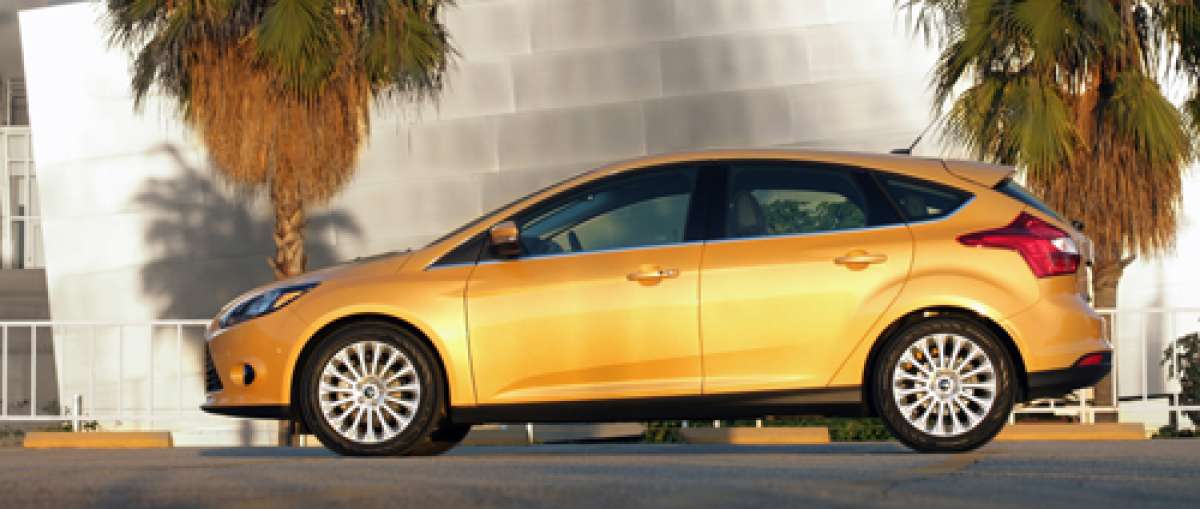It happens every once in a while. I spend a couple days with a vehicle and decide, "This is a car I could live with." Add to that relatively short list (besides my Mazda5, Saab 9-5, and the Audi R8), the Ford Focus Hatchback for 2012. And, unlike some automotive reviewers, my wife and I actually own cars and we have a 2002 Dodge Neon that could need replaced in a year or two. This hatchback will be on the short list.
The Ford Focus that was loaned to me by Ford for a week of testing grew on me that quickly. The instant appeal probably emanates from the fact that it more closely resembles a station wagon than a hatchback. It's a highly functional vehicle in a compact package.
The Ford Focus is truly a global vehicle for Ford following a global development program under the company’s One Ford strategy. Before, there used to be one Focus for North America and a typically more sophisticated, engaging Focus for the rest of the world because Americans didn't cotton much to compacts. This Focus will be on sale in 120 countries with tweaks for local regulations and markets.
The Ford Focus does have an SFE model in the sedan version that is going to get 40 mpg on the highway but you're going to pay more for it. That trim level isn't available in the hatchback, but it's rated at a more than respectable 28 city and 38 mpg. It's mated to a six-speed automatic transmission and my fuel economy during a week of mixed driving was 31.9 mpg. That's fantastic in my view for a vehicle that is so family friendly and comfortable to drive.
Part of that comfort comes from the quiet ride. Noise, vibration and harshness levels have been reduced and driving dynamics enhanced by the improved stiffness of the body structure, with 30 percent greater rigidity than the previous Focus model. Ford is really leading the way with quieter rides in its compacts and sub-compacts. The company is touting the technology in the Focus matches more expensive cars, but it really succeeds by providing a ride that is as quiet as cars costing much, much more.
The Focus is fitted with a completely new 2.0-liter gasoline direct-injection dual overhead cam four-cylinder engine that combines high-pressure direct injection and twin independent variable camshaft timing for enhanced performance and fuel efficiency. This engine delivers more power than the current 2.0-liter Duratec unit featured in the North American Focus, while contributing to projected fuel economy gains of more than 10 percent.
It's rated at 160 horsepower at 6500 rpm and 146 lb. ft. of torque at 4,450 rpm. It's not going to snap you into your seatbacks under even the hardest of acceleration but it's more than sufficient for 99 percent of all driving circumstances. Would a little more power be nice? Sure, but you would have to sacrifice a lot of fuel economy. It's not worth the trade-off.
The Focus has a next-generation airbag system with enhanced chest protection technology. The new airbag uses a reconfigured curve-shaped tether system that pulls in the lower section to create a “pocket” to help lessen the impact of the airbag on the driver’s chest and ribs in frontal crashes.
It can't be underscored enough how important that is. Smaller and obese drivers who are positioned closer to the steering wheel can be subject to strong forces from deployed airbags. This will benefit them most.
Ford’s side airbags feature unique shoulder vents that stay open and reduce pressure for smaller occupants who typically benefit from reduced forces. Taller occupants whose shoulders block the vent could benefit from the higher pressures.
Focus also will be Ford’s first car ever to feature front passenger airbags with adaptive venting technology that diverts some of the gas from the airbag inflators through vents outside of the airbags. The restraints control module – the control center of Ford’s advanced safety systems – adjusts the level of venting based on seat position.
One piece of technology I admit not to testing to its full capabilities is the advanced torque vectoring system. As Ford explains it, the system acts as limited-slip differential for a balanced distribution of torque at the front wheels. That leads to reduced understeer, better traction, and improved turn-in. It all contributes to better handling through curves.
Pricing for the hatchback that I drove starts at $18,065 in the SE trim level with a five-speed manual or six-speed automatic transmission. It's a $3000 bump up to the SEL trim with Bluetooth and other features standard. The Titanium trim level comes in at $22,765 with fancy seats and other upgrades.
VITAL STATISTICS
* Wheelbase: 104.3 inches
* Length: 171.6 inches
* Width: 71.8 inches
* Height: 57.7 inches
* Curb weight: 2940 lbs.
* Engine: 2.0-liter, inline four cylinder
* Horsepower: 160 horsepower at 6500 rpm
* Torque: 146 lb. ft. of torque at 4,450 rpm
* EPA estimated mpg city/highway: 28/38
* Base price: $18,065
* As-tested price: $21,065
* Also consider: (a comparative vehicle) Hyundai Elantra Touring, Honda Fit, Nissan Versa, Suzuki SX4





